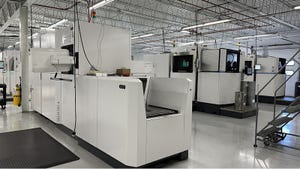April 5, 2011
Touting what it calls the largest release in the product'shistory, PTC released a majorupgrade to its Windchill Product Lifecycle Management (PLM) platform, featuringa completely redesigned and more accessible user interface, a heightened focuson process improvement along with new modules to support field servicerequirements and product analytics.
The Windchill10.0 upgrade aims to help companies address the escalating complexitysurrounding product development, driven by a range of factors, including anincreased focus on product differentiation, mounting regulatory requirements,quality pressures and attention to the environmental impact of productdevelopment. "Our customers are facing far more complexity in their productsand it's a huge challenge," notes Michael Distler, product marketing directorfor Windchill. "But the challenges go far beyond the traditional boundaries ofengineering. There are concerns about field service productivity, hardware andsoftware coordination, quality issues, issues around product cost andenvironmental compliance. Appropriately, with the 10.0 release, the Windchilltent has expanded and it's not just engineering, but other groups within theproduct development ecosystem are now involved."
One of the primary themes of the new release is increasingthe type of content that Windchill can manage. For example, Windchill 10.0unifies its ECAD data management capabilities, offering a common userexperience and single repository for managing ECAD data that is consistent withits approach for handling MCAD data. In addition, there are new integrationsfor supporting and managing embedded software data as part of the Windchill10.0 repository, which will improve visibility and eliminate many of thebottlenecks and miscues that erupt from having to manage software and hardwarecomponents in separate systems. "It can be a real headache for our customersmaking sure they get the right version of the software," Distler explains."This keeps the software guys in the loop and helps connect two worlds."
Windchill 10.0 also sets the stage to better connect the PLMplatform to the field service world. To ensure that the process of service andspare parts planning is in sync with product development, PTC will buttressfuture maintenance releases of Windchill 10.0 with capabilities for managing serviceinformation and spare parts lists along the lines of a BOM (Bill of Materials)for engineering or manufacturing, he says.
Process improvement is another area of focus in the upgrade.To accommodate companies' push into top-down-design and configurationmanagement, Windchill 10.0 supports a number of optimizations for such businessprocesses as Detailed Design, Variant Design and Verification and Validation.For example, a new Design in Context feature filters out the product structureto deliver the right information depending on a user's need as opposed torequiring them to download an entire product model. The new WindchillInterference Management Service, which can be configured to run as needed,automatically simulates moving parts in a model to check for interferences,another boost for companies trying to optimize processes around designing manyvariations of a single product.
Know More Through Analytics
To help product development organizations "know more" aboutwhat they're building, Windchill 10.0 draws heavily on prior PTC acquisitionsto build out a suite of capabilities in the area of product analytics. The newWindchill Quality Solution, which builds on the formerRelex product line, is designed to reduce the cost ofpoor quality by helping engineers prevent repeat errors and build reliabilityand risk management into the product lifecycle. New offerings under thisumbrella include a CAPA (Corrective Action Preventive Action) module forhelping to resolve problems by improved monitoring and root cause identification.
In the same vein, Windchill Product Analytics (formerlyknown as the Insight products) provides users with early knowledge of product performance in suchareas as cost and carbon footprint analysis. These new areas complementWindchill Product Analytics' existing solutions for materials and substancemanagement, which helps companies meet their reporting requirements forcompliance with regulations like REACH and RoHS.
To better deliver all of these new areas of functionality,Windchill 10.0 has been completely revamped with a new user interface intendedto both appeal to more casual users and make tasks more efficient for powerusers. The ability to access menus and functions via right clicks as opposed topull-down menus, new wizards and customization capabilities are just a few ofthe user interface enhancements that should broaden up use of Windchill to awider audience, according to Terry Gimbre, engineering manager at Thales Communications,a manufacturer of defense communications and software. Thales, a long-timeWindchill customer, currently has about 300 Windchill seats across a variety ofusers and departments.
"We have users, from CAD engineers to the CEO," Gimbre says."Many have been reluctant to use the system, but with the new UI, it's veryuser friendly." While Gimbre doesn't see the new UI necessarily attracting newWindchill users, he believes the changes, in addition to tighter integrationwith mainstream business tools like Microsoft Office, will increase usage ofthe tool.
Windchill 10.0 is available now, but some of the quality,service and product analytics solutions will be released later this year.
You May Also Like





